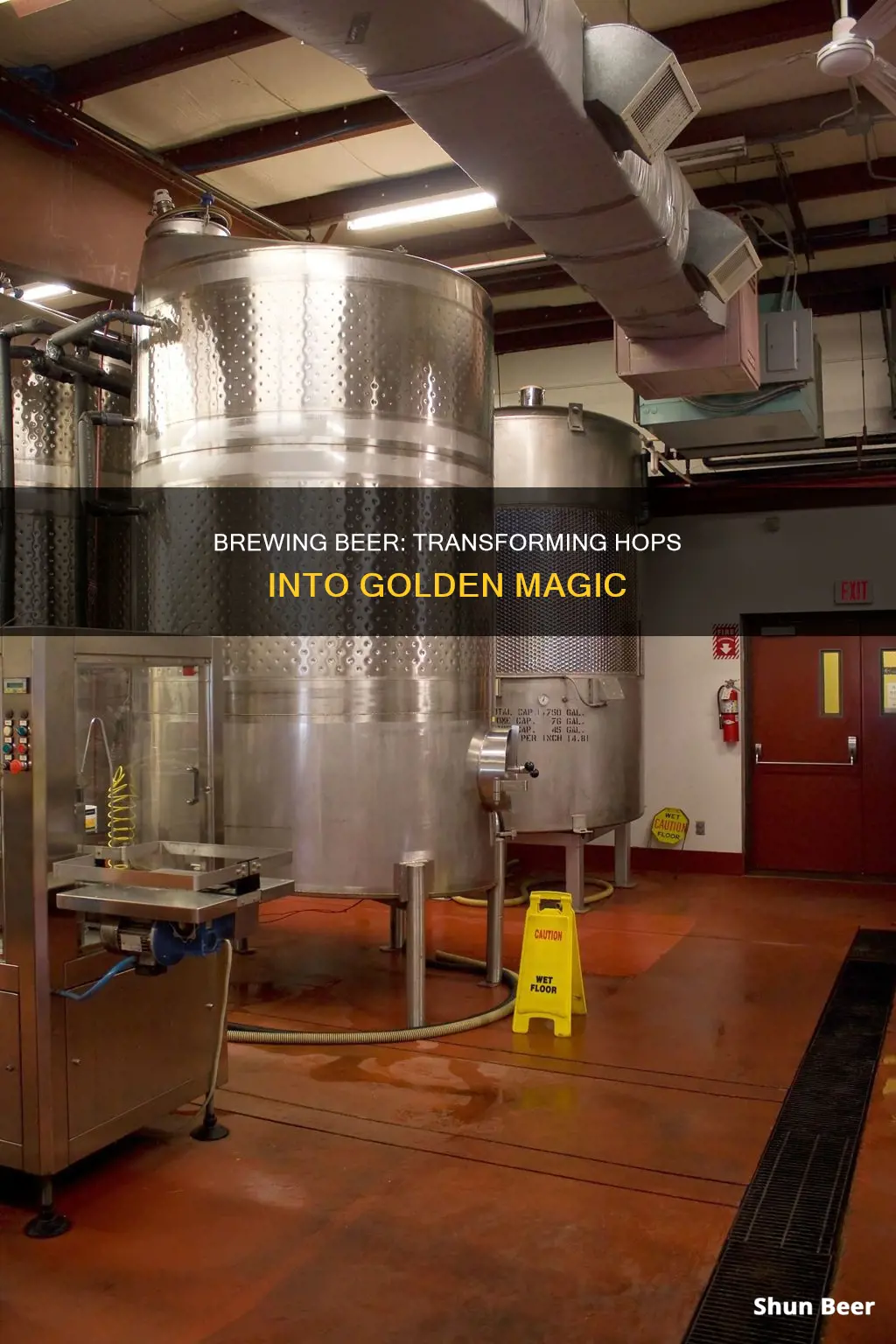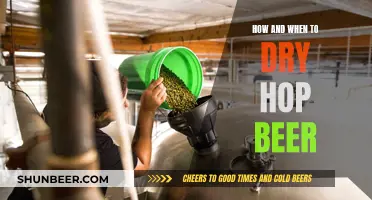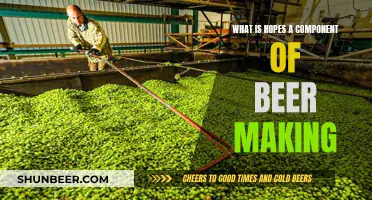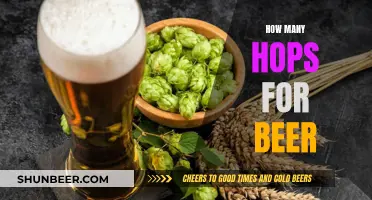
Hops are an essential ingredient in beer, providing bitterness, flavour, and aroma. The different ways to add hops to your beer include boiling, steeping, dry hopping, and mashing. The timing of hop addition during the brewing and fermentation process is critical, as it determines the amount of bitterness, flavour, and aroma in the final product. Hops can be added in the form of cones, whole flowers, or pellets, and the specific type and amount of hops used also play a significant role in the characteristics of the beer.
What You'll Learn

The role of hops in beer
Hops are one of the four essential ingredients in beer, alongside barley, yeast, and water. They are the cone-shaped flowers of the female Humulus lupulus plant, also known as the common hop. The plant is a cousin of the cannabis plant, though hops contain no THC. Hops are added to the boil stage of brewing, as it takes around an hour to unleash the "alpha" acids that bitter and balance the sweetness of the malt.
Hops are most often associated with bitterness, but they can also be used to add flavour and aroma to beer. They contain a substance called lupulin, which contains essential oils, protein, and minerals, as well as bittering agents that are extremely important when brewing beer. The bittering agents provide the beer's bitterness, promote stable foam for the head, and act as preservatives, extending the beer's shelf life by natural means.
The type and timing of hops used will vary depending on the style of beer being brewed and the desired flavour profile. For example, if a bitter taste is desired, hops can be added during the kettle boil. If the brewer wants to utilise the essential oils in the hops, they can be added during fermentation, also known as dry hopping, or after fermentation.
Craft brewers, in particular, love lupulin to pack flavour into IPAs. There are around 250 different varieties of hops, and the choice of hop will contribute different flavour notes and aromas to the beer. For example, Columbus hops add bitterness, as well as earthy and spicy notes, while Mosaic hops offer notes of berry and stone fruit.
Hops' Magic: Brewing Beer's Unique Flavors
You may want to see also

How to harvest hops
Hops are the female flower cones of the hops plant, a long, climbing vine. They are one of the main ingredients in beer, added during the brewing process to preserve the beer and give it its classic bitter flavour.
When to Harvest
Hops harvesting usually takes place in August or September when the cones have had time to dry out on the vine. To check if the cones are ready to harvest, gently squeeze the cone with your fingers. You want it to feel light and springy, with sticky sap coming out. If it feels damp and squishy, it is not ready. Another way to check is to roll the cone in your hands and smell it. If it has a pungent smell between cut grass and onion, it is ready to harvest.
How to Harvest
There are two methods for harvesting hops: picking by hand or cutting down the vine. For first-year hops, it is recommended to pick the cones by hand. For all subsequent years, you can cut the vine down. If you are cutting the vine, cut two to three feet above the ground to prevent injury to the root system and crown. Be sure to wear durable, abrasion-resistant clothing, gloves, and goggles during the harvest, as hops have hooked hairs that can cause skin rashes and small cuts.
Drying Hops
Once you have harvested your hops, you will need to dry them before using or storing them. Fresh hops are about 80% water, so if you are adding them directly to your brew, you will need to use more than you would with dry hops. If you are not using them right away, it is best to dry them. The key to drying hops is to do it quickly without heating them too much. The ideal temperature for drying hops is below 140°F (60°C). There are several methods you can use to dry hops:
- Food dehydrator: This is the easiest way to dry hops as it ensures air movement but does not get too hot.
- Well-ventilated oven: Spread the hops out on a pan and place them in the oven, ensuring adequate airflow. Do not let the temperature exceed 140°F (60°C).
- Hop drying screen: If you have a small amount of hops, spread them out over a window screen or a house air filter in a warm, dry location. Place a fan under or next to the screen to maintain airflow, and elevate the screen to improve airflow.
Storing Hops
Once your hops are dried, you will need to store them in a sealable bag, removing as much air as possible before placing them in the freezer.
Sour Beers: Do They Have Hops?
You may want to see also

Preparing hops for brewing
Harvesting:
The first step is to harvest the hops at the right time. Depending on the location, the harvest usually occurs between mid-August and September. It is important to pick the hops when they are over-ripe rather than under-ripe to ensure the optimal level of alpha acids. A common sign that the hops are ready for harvest is when the cones start to fan out and bulge, and the edges start to dry out and brown slightly. Another test is to give the cone a light squeeze; if it feels light and dry and springs back, it is ready for harvest. The cones should also have a sticky texture and a pungent smell between cut grass and onion.
Drying:
After harvesting, the hops need to be dried to preserve their freshness and flavour. This process should be done quickly, within three days, and at temperatures not exceeding 140°F (60°C) to prevent oxidation and isomerization. There are several methods for drying hops, including using a food dehydrator, a well-ventilated oven, or a hop-drying screen. The key is to maintain adequate airflow and temperature control to ensure the hops are dried without losing their aromatic qualities.
Storage:
Once the hops are sufficiently dried, they need to be stored properly to maintain their freshness. It is recommended to separate the hops into small batches, weighing them out, and placing them in airtight containers like plastic freezer bags, food saver bags, or airtight jars. Remove as much air as possible from the containers to prevent oxygen contamination, which can ruin the hops. Label the containers with the type of hop and store them in the freezer for future use.
Adding to the Brew:
When ready to use the hops for brewing, there are several methods for adding them to the beer:
- Boiling: Adding hops through boiling will increase the bitterness of the brew. This is done by boiling a mixture of malt extract and water with the hops for a few minutes, then straining it into the fermenter.
- Steeping: To add flavour to the beer, steeping is used. This involves heating water to a boil, adding the hops, then removing the water from the heat and allowing the hops to steep before adding the mixture to the brew.
- Dry Hopping: This method is typically used to add aroma to the beer. The hops are thrown directly into the fermenter, either loose or in hop bags, usually three days after fermentation has started. Dry hopping can also add a fresh flavour to the beer.
Each of these methods can be adjusted and combined to suit personal preferences and brewing goals. The type of hop, the amount used, and the way it is prepared and added to the brew all play a crucial role in determining the final characteristics of the beer.
Zywicki Portor Beer: Hops or No Hops?
You may want to see also

Adding hops to beer
Hops are added to beer to impart bitterness, flavour, and aroma. The timing of the addition of hops to the brewing process will determine which of these characteristics is emphasised. Hops added at the beginning of the boil will create bitterness, hops added during the middle of the boil will add flavour, and hops added at the end of the boil will create aroma.
Boiling
Boiling hops is the best way to add bitterness to your beer. First, add malt extract to water and bring to a gentle boil. Then, add hops and boil the mixture for a few minutes. Let it rest, then strain the mixture into a fermenter.
Steeping
Steeping hops in boiled water will add flavour to your beer. After boiling water, add hops and take the water off the heat. Allow the hops to steep, then add the mixture to your brew with cold water.
Dry Hopping
Dry hopping is the best way to add aroma to your beer. Throw hops directly into the fermenter, either loose or in hop bags, three days after fermentation has started.
Timing
The timing of hop additions will depend on the desired characteristics of your beer. For example, if you want a very bitter beer, you would add a large amount of hops at the beginning of the boil. If you want a more well-rounded beer with flavour and aroma, you would add smaller amounts of hops at the middle and end of the boil.
Amount
The amount of hops you add will depend on your personal preference and the desired characteristics of your beer. Generally, 10-20g of hops is enough for a home brewing kit. However, you may want to add more or less depending on how much flavour and aroma you want.
The Historical Addition of Hops to Beer
You may want to see also

The timing of adding hops
Hops are added to beer at different stages to achieve different results. The three main roles hops play in the beer-making process are adding bitterness, flavour, and aroma.
Bittering Hops
Bittering hops are added once the wort has been collected in the kettle and a rolling boil has been achieved. They are usually boiled for 60 minutes, although some recipes call for as little as 30 minutes. All beers have bittering hops to balance the sweetness of the malt. Without the bitterness from the hops, the beer would taste overly sweet. Hops added at the beginning of the boil are considered bittering hops.
Flavoring Hops
Flavoring hops are added with between 15 and 30 minutes remaining in the boil. In this time frame, very little bitterness will be extracted from the hops, but the crisp hoppy flavour will be imparted. Flavoring hops are typically added mid-boil, around 15-30 minutes remaining.
Aroma Hops
Hop oils that are responsible for aroma are extremely volatile and will be driven off in the steam of the boil almost immediately. Therefore, aroma hops must not be boiled for long. They are typically added during the last 5 minutes of the boil or at flame out (when the kettle is removed from the heat). Adding hops at flame out will produce the maximum amount of aroma.
Dry Hopping
Dry hopping is the process of adding hops directly to a beer post-fermentation. This method is ideal for adding aroma to the beer. The best time for dry hopping is three days after fermentation has started. If the hops are added too early, some aroma will be lost.
First Wort Hops (FWH)
First Wort hops are added to the kettle while the lauter and/or sparge are running off. There is some debate as to whether FWH adds unique flavours or bitterness of a different, softer character. However, there is data to suggest that FWH consistently adds more IBUs to the beer.
Boil Hops
Hops added at the start of the boil are considered bittering hops, those added about 30 minutes remaining are flavouring hops, and those in the final 10 minutes or less are aroma hops. However, this is not always the case, as the quick-start nature of alpha-acid isomerization and hops-oils volatilization means that hops added during the boil can all be considered bittering hops.
Post-Boil Hops
Post-boil hops are added once the heat is killed. The temperature will still be over the 77°C threshold that will act to volatilize the hops oils, but they won't be at full-boil temperatures, increasing the odds of survival for the extracted oils.
Whirlpool
Whirlpooling is the practice of stirring the wort to form a whirlpool that will gather solids in the centre of the kettle to aid in getting a "clean" runoff. This is done post-boil, and hops can be added during this time to preserve almost all of their character.
Hopback
A hopback is a device that is packed with whole-flower hops and then "washed" with the post-boil wort en route to the chiller. This method adds hops aroma and flavour.
Hop Bursting
Hop bursting is a technique popularized around 10-15 years ago where the majority of the hops are added in the last five minutes of the boil.
Hops Beer: The Secret Behind the Bitter Buzz
You may want to see also
Frequently asked questions
Hops are used to add bitterness, flavour, and aroma to beer.
Hops are usually harvested between mid-August and September. The cones should feel fairly dry and papery when pinched, and they should spring back after a squeeze.
There are several ways to prepare hops, including boiling, steeping, and dry hopping. Boiling is used to add bitterness, steeping is for adding flavour, and dry hopping is for adding aroma.
Some popular types of hops include Chinook, Columbus, Simcoe, Cascade, Fuggle, and Kent Golding.







